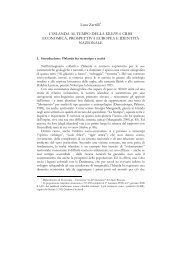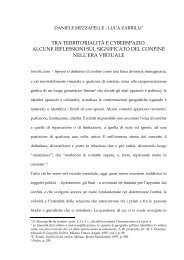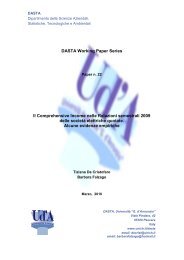DASTA Working Paper Series Life Cycle Assessment in the tourism ...
DASTA Working Paper Series Life Cycle Assessment in the tourism ...
DASTA Working Paper Series Life Cycle Assessment in the tourism ...
You also want an ePaper? Increase the reach of your titles
YUMPU automatically turns print PDFs into web optimized ePapers that Google loves.
<strong>DASTA</strong> – <strong>Work<strong>in</strong>g</strong> <strong>Paper</strong><br />
Environmental impact assessment method The follow<strong>in</strong>g <strong>in</strong>dicators were<br />
used to assess <strong>the</strong> environmental impacts: climate change (kg CO2 eq./m²),<br />
acidification (kg SO2 eq./m²), eutrophication (kg PO4 eq./m²), and nonrenewable<br />
energy (MJ/m²).<br />
Special features The study highlights <strong>the</strong> necessity to use a specific LCA<br />
software for build<strong>in</strong>g design and <strong>the</strong> importance of prevent<strong>in</strong>g environmental<br />
impacts, act<strong>in</strong>g at <strong>the</strong> design phase.<br />
Ma<strong>in</strong> limitations The <strong>in</strong>dicators chosen for <strong>the</strong> characterization phase<br />
referred only to four environmental impact categories.<br />
3.9 LCA of accommodation and spa services of an Italian hotel (Floridia,<br />
2007)<br />
Methodology Conventional LCA.<br />
Products Tourist structures and services of hotel Terme Belvedere <strong>in</strong><br />
Abano Terme, Veneto.<br />
Objectives The objectives of <strong>the</strong> LCA studies are as follows: assessment of<br />
<strong>the</strong> environmental damages generated by a hotel build<strong>in</strong>g along its life cycle<br />
(from <strong>the</strong> construction to <strong>the</strong> change of use, till <strong>the</strong> demolition phase);<br />
identification of environmental hot-spots to def<strong>in</strong>e potential improvement<br />
actions and management strategies for structures and services provided (i.e.,<br />
accommodation and spa services).<br />
Functional unit Because hotels are complicated systems, due to several<br />
processes <strong>in</strong>volved with<strong>in</strong> <strong>the</strong>ir life cycle, <strong>the</strong> authors decided to outl<strong>in</strong>e a<br />
functional unit consider<strong>in</strong>g <strong>the</strong> follow<strong>in</strong>g elements: build<strong>in</strong>g dimension, which<br />
ma<strong>in</strong>ly affects material consumption, management and disposal; number of<br />
tourist stays per year, which are strongly related to operat<strong>in</strong>g stage of hotel<br />
structures; open<strong>in</strong>g period of <strong>the</strong> hotel; life span of structures.<br />
System boundaries The life cycle model was focused on <strong>the</strong> life of hotel<br />
structures from cradle to grave. In fact, <strong>the</strong> follow<strong>in</strong>g phases were <strong>in</strong>cluded <strong>in</strong><br />
<strong>the</strong> system boundaries: extraction of raw materials; manufactur<strong>in</strong>g of build<strong>in</strong>g<br />
products; build<strong>in</strong>g construction; use and management of structures, <strong>in</strong>clud<strong>in</strong>g<br />
activities of hotel ma<strong>in</strong>tenance; end of life of build<strong>in</strong>g materials.<br />
Data quality Primary data on <strong>the</strong> usage of <strong>the</strong> hotel build<strong>in</strong>g for<br />
accommodation and spa services (e.g., consumption of energy, water and<br />
products, and waste production) were collected directly on site. As regards<br />
<strong>the</strong> build<strong>in</strong>g construction phase, architects and technical experts collaborated<br />
to identify materials and to estimate quantities because no bill of quantities<br />
was available. Moreover, energy consumption by <strong>the</strong> mach<strong>in</strong>ery and<br />
equipment used <strong>in</strong> <strong>the</strong> build<strong>in</strong>g yard (e.g., crane, cement mixer, etc.) was<br />
calculated on <strong>the</strong> basis of data sheets and time estimations. F<strong>in</strong>ally,<br />
databases <strong>in</strong>cluded <strong>in</strong> <strong>the</strong> SimaPro 7.0 software, as well as surveys were<br />
used to complete <strong>the</strong> LCA <strong>in</strong>ventory.<br />
De Camillis, Raggi, Petti 12






